#Fecit Studio
Explore tagged Tumblr posts
Text

Hate - Bellum Regiis
Blackened Death Metal from Warsaw, Poland
After a dozen furious and highly acclaimed albums since 1996's Daemon Qui Fecit Terra, Bellum Regiis is the Polish quartet's thirteenth album, on which they cultivate a bolder and more aggressive style than ever before. On the nine songs of Bellum Regiis, singer/guitarist ATF Sinner, guitarist Domin, drummer Nar-Sil, and bassist Tiermes hone a modern sound full of eerie atmosphere and depth. Produced by David Castillo (Candlemass, Carcass, Dark Tranquility, Katatonia) at Stockholm's Grondahl Studio, Bellum Regiis is lyrically a “more human and personal” album than Rugia. According to founder Sinner, the songs on Bellum Regiis are a contemporary acoustic and visual exploration of “the struggle for power and everything that comes with it.” More than three decades into his illustrious career, Sinner is as profound and poetic as ever, if not more so, on Bellum Regiis. One example is “A Ghost of Lost Delight,” a song marked by a strange melancholy and thoughtfulness. Hate deals with the cycles of life and death and ultimately offers a powerful and positive plea for hope in dark times that is as relevant in 2025 as it was in past eons.
1. Bellum Regiis 06:43 2. Iphigenia 06:01 3. The Vanguard 06:00 4. A Ghost of Lost Delight 06:33 5. Rite of Triglav 01:36 6. Perun Rising 05:15 7. Alfa Inferi Goddess of War 04:30 8. Prophet of Arkhen 04:41 9. Ageless Harp of Devilry 04:53
Release date: May 2nd, 2025 via @metalbladerecords
@hateofficial
#polanddeathmetal#hateband#deathmetal#deathmetalband#oldschooldeathmetal#melodicdeathmetal#newdeathmetalsongs#brutaldeathmetal#extremedeathmetal#blackdeath#blackdeathmetal#deathcore#mythology#blackeneddeathmetal#deathmetalpromotion#thrashmetal#deaththrash#thrashdeath#extrememetal#supporttheunderground#newalbum#2025release#albumcover#bandcamp#bellumregiis#metalbladerecords#Bandcamp
3 notes
·
View notes
Text
Analisi dei fregi ed epigrafi di San Gregorio a Pietracupa
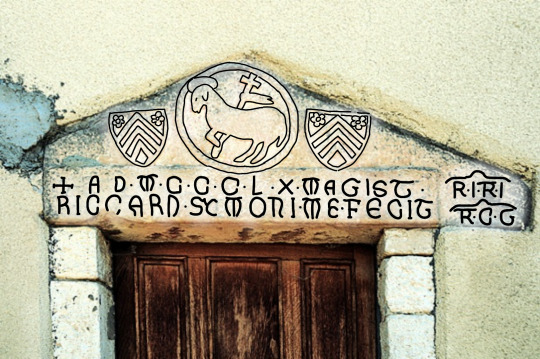
Lo studio di ricerca sul caso insolito, del portale antico di San Gregorio a Pietracupa, procede, e non senza intoppi purtroppo.
Rimane enigmatico il casato al quale appartenga lo stemma, della committenza che commissionò l'intera opera al magister Riccardo di Simone, anche se per questa circostanza, ci sembra opportuno avanzare l'ipotesi possa trattarsi di una personalità del posto, che ebbe a che fare con questo feudo e con il luogo di culto stesso, forse il signore Roberto di Pietracupa, al quale stiamo cercando di collegare i due blasoni muniti di tre caprioli, due rosette ed uno sfondo apparentemente rosso, in base ai residui che si trovano su tutta l'architrave.
Nel rettangolo sottostante, ecco evidenziata meglio l'intera epigrafe che attesta il lavoro di Riccardo, con alcune ipotesi di completamento:
"+ AD • M•C•C•C•L•X • MAGIST(er) • RICCARD(us) (filius) • SYMONI • ME • FECIT "
tradotto:
"nell'Anno del Signore 1360, il magister Riccardo di Simone mi fece"
più ardua è invece la ricerca per trovare un completamento nell'epigrafe dello spigolo destro, abbreviata all'osso.
Dalle lettere evidenziate, grazie ad un calco in carboncino, si è potuta solo identificare la forma e un probabile significato alfabetico.
Dalla nostra ricostruzione, leggesi l'acrostico:
" R • I • TR • I • TR • C^ • G "
Dove le R con annessa dobbiamo lineetta, sono facilmente distinguibili come T ed R consecutive nelle due parole.
Un vero rompicapo!
#arte#italia#medioevo#storia#archeologia#cultura#storia dell'arte#molise#Pietracupa#Regno di Napoli#Agnus Dei#Riccardo di Simone
0 notes
Text

Barbara Longhi was an Italian painter, much admired in her lifetime as a portraitist, although most of her portraits are now lost or unattributed. Her work, such as her many Madonna and Child paintings, earned her a fine reputation as an artist. She was also known for her religious paintings and her depictions of women in domestic settings.
Barbara Longhi was born on 21 September 1552 in the central Italian city of Ravenna, where she spent her entire life. Her father, Luca Longhi was a well-known Mannerist painter, and her older brother Francesco was also a painter. Both siblings received painting education from their father and were part of his studio, with Barbara assisting in such projects as work on large altarpieces. She also modeled, and gained some familiarity with the process of marketing her artwork to patrons. Although her training was completed by 1570, her ties to her family and to her father's workshop remained strong. Very little is known of her life, not even whether she was ever married.
Most of Longhi's paintings are unsigned, but on one she included the initials "B.L.F.", standing for "Barbara Longhi fecit" ("made by Barbara Longhi") and on another, "B.L.P.", for "Barbara Longhi pinxit" ("painted by Barbara Longhi"). As almost all of her work was unsigned, it is unknown how many paintings she created or are still in existence. Only about fifteen are definitively attributed to her. Of those, about twelve are paintings of the Virgin and Child; such paintings were very popular during the Counter-Reformation. It is thought that some of her works may be erroneously attributed to her father.
#barbara longhi#perioddramaedit#history#edit#kaitlyn dever#kaitlyndeveredit#italian renaissance#renaissance#rinascimento#donne italiane#donne nella storia#donne della storia#donneitaliane#women of renaissance#renaissance italy#renaissance women#women artists#women of history#women in history#italian art#art#paintings#16th century#italiansedit#luca longhi#historical figures#historical#art history#historyedit#history edit
44 notes
·
View notes
Text

#WatercolorWednesday: Twee Exotische Vogels [Two Exotic Birds] by Dutch artist Aert Schouman, 1762. These two "exotics" are a Guianan Cock-of-the-Rock (Rupicola rupicola) from South America (L) and an Orange-breasted Bunting (Passerina leclancherii) from Mexico (R).
Aert Schouman (Dutch, 1710-1792) Twee Exotische Vogels [Two Exotic Birds], 1762 illustration on paper, watercolor and pencil inscription, verso, pen (repeated from pencil text): 'De Hoep Hen, Levens grotee AS fecit int Cabint van ZH 176[2]' h 366 mm × w 258 mm Object # RP-T-1898-A-3707 [Rijksmuseum collection]
"The bright orange paint with which Aert Schouman painted the plumage of this South American Cock of the Rock splashes off the paper. The artist was already praised in the 18th century for his intense paint colours. Orange, red and peacock blue were especially appreciated. Like many 17th and 18th century artists, Schouman prepared his paint colors himself in the studio, using recipes passed down from master to student."
#birds#birds in art#Guianan Cock-of-the-Rock#Orange-breasted Bunting#natural history art#painting#watercolor#illustration#ornithology#ornithological illustration#Aert Shouman#Dutch art#18th century#Rijksmuseum#animals in art
3 notes
·
View notes
Text
To see the web page which goes with this choose the link [in blue] below.
Seven Emblem books and two others!
Two sort of emblematic books (A&B) and Seven(1-7) emblem books in contemporary or original bindings!
1) Andres Alciati 1492 – 1550
V.C. Emblemata (Viri Clarissimi) Emblemata. Cum Claudij Minois ad eadam Commentariis & Notis Posterioribus. Quibus Emblematum omnium aperta origine, mens auctoris explicatur, & obscura omnia dubiáque illustrantur.
Lugduni (Lyon), Hæred. Gvlielmi Rovilii, 1600. 1600. Bound in coeval vellum with author and title on the spine in an early hand. Octavo ã8, e4, i8 A-Eee8, Eee*2 Fff8 Ggg4.
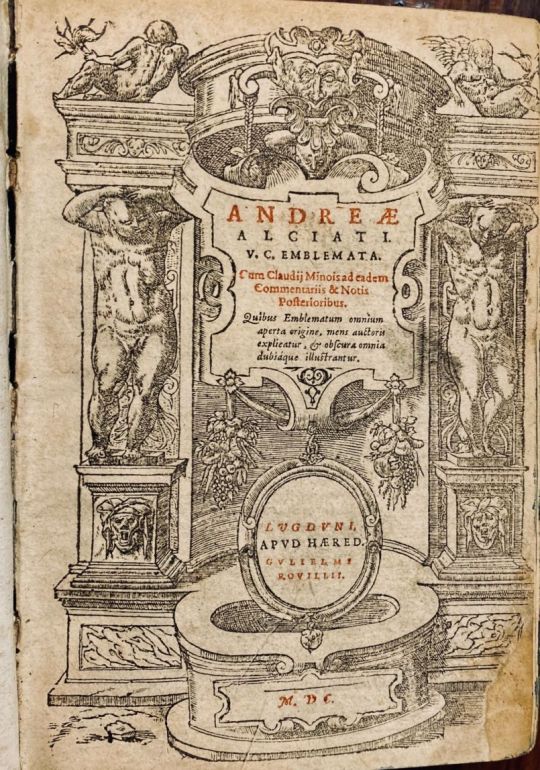
The ultimate reference for this book is Daly’ Andres Alciatus Index Emblematicsus 1985; ; Landwehr, J. Romanic emblem books; 89 ; Adams, A. French emblem books; F.063; Emblem books at the Univ. of Illinois; A32; Green, H. Andrea Alciati and his books of emblems,; 127; Baudrier, 1895-1921, v. 9, p. 464-65;. Item #738G
The emblem book, which attained enormous popularity in continental Europe and Great Britain, while it is possible to trace it back before was certantly made most popular by Alciati. . Alciato’s emblems were first published in Augsburg in Germany (two editions in 1531 and one in 1534); from 1534 onwards publishing shifted to France and remained there for the next thirty years. Wechel, who printed the Paris editions (from 1534), are like those in Augsburg. He can be said to have set the standard for clear presentation of emblems, with each emblem beginning on a fresh page, featuring the motto or title, the pictura below that, and then the subscription/epigram or verse text the main focus of publication for emblems shifted more firmly to Lyons from the mid 1540s, The 1550 Latin edition by Rouille is the first to have 211 emblems (the whole corpus, apart from the so-called obscene emblem ‘Adversus naturam peccantes’) illustrated. This edition includes biography of Andrea Alciati (leaves i1-i8). These emblems depict Alciati’s concern for the eternal nature of man and its contradictions, the attentive ear to the popular speech, the unfolding of the personality, madness, the reflection on human existence, the relationship between man and the woman, the struggle between reason and passion, and to the satire of society and its rules and rulers.
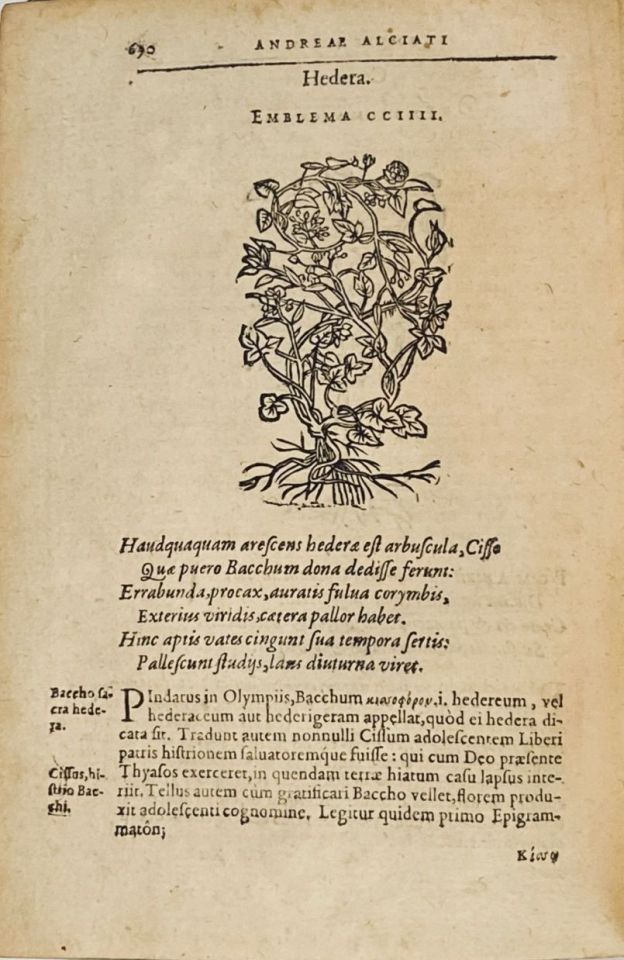
A) CARTARI 343J Vincenso Cartari. 1531–1569
Seconda novissima editione delle Imagini de gli dei delli antichi di Vicenzo Cartari …Ridotte da capo a piedi alle loro reali, & non più per l’adietro osseruate simiglianze. cauate da’marmi, bronzi, medaglie, gioie, & altre memorie antiche; con esquisito studio, & particolare dligenza da Lorenzo Pignoria … Aggionteui le annotationi del medismo sopra tutta l’opera, & vn discorso intorno le deità dell’Indie orientali, & occidentali, con le loro figure tratte da gl’originali, che si conseruano nelle Galleri de’principi, & ne’musei delle persone priuate. Con le allegorie sopra le imagini di Cesare Malfatti … Et vn catalogo di cento più famosi dei della gentilità. Con l’aggiunta d’vn’altro catalogo de gl’autori antichi, & moderni, che hanno trattato questa materia, ordinato & raccolto dal medesimo Pignoria che ha accresciute le annotationi & aggiunte molte imagini.
In Padova, Nella stamparia di Pietro Paolo Tozzi. 1626. Quarto, 9 1/4 x 6 1/2 in 224×162 mm. Signatures: ‡8 ≠≠1,a6, ‡‡4 [∏2 FOLDOUTS] A-Z8 ,AA-OO8 (38 pages, 589 pages illustrations, two folded plates) [[38] pages, 589 pages illustrations, two folded plates 24 cm]. 2 double-page woodcuts and 227 full-page and in-text woodcuts of the ancient gods by Cesare Malfatti. * *. *
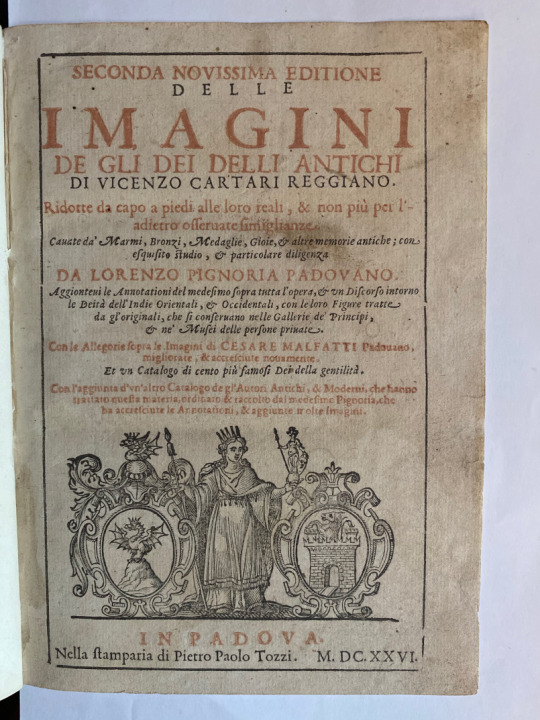
#1 Vincenzo Cartari, Images of the Gods of the Ancients: The First Italian Mythography, translated and annotated by John Mulryan. Medieval and Renaissance Texts and Studies vol. 396. Tempe, AZ: Arizona Center for Medieval and Renaissance Studies, 2012.
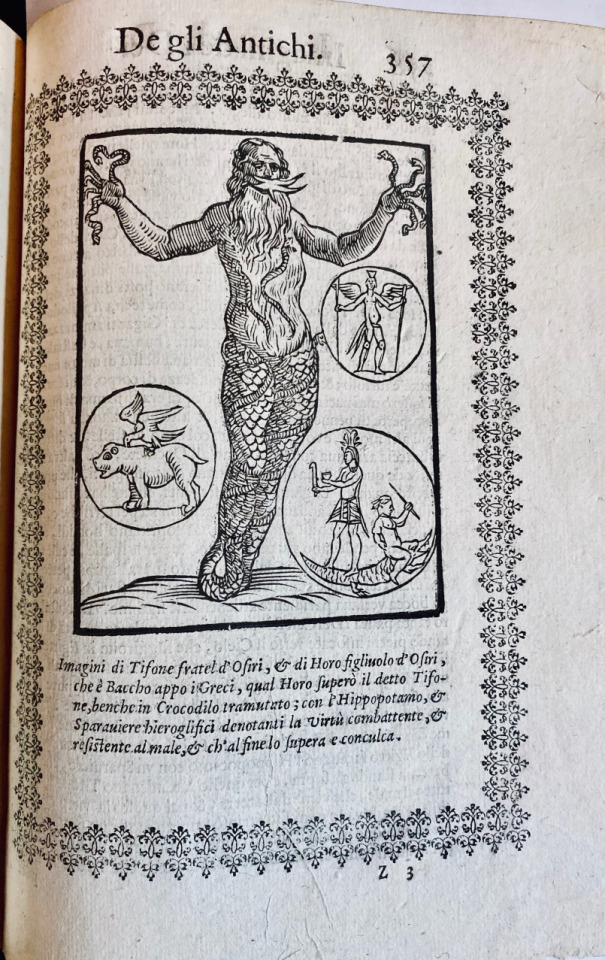
Praz 36; Cicognara 4686; Graesse II.56; Nagler XXII.15, ; Harvard 156.108; JCB Library catalogue; 2:198; Sabin 11104.; BM. STC.(Ital.) 152.; ‘Choix 4280. See Also: Mortimer, Italian, 108 note. Caillet 2047 (French trans.) Brunet I,1601. Graesse II,56.Univ. Cat of Art, 287. Arntzen & Rainwater H35.Dekesel 16th, C11. And :
1)Sonia Maffei, ‘Le imagini de i Dei degli antichi di Vincenzo Cartari: Dalla poesia all’archeologia’ http://dinamico2.unibg.it/cartari/leimaginideiDei.html
2) Marco Urdapilleta Muñoz, ‘El bestiario medieval en las crónicas de Indias (siglos XV y XVI)’, Latino América, Revista de Estudios Latinoamericanos, 58 (2014), 237-70. 5160.235500
3) Miguel A. Rojas Mix, América imaginaria (Barcelona, 1992) LB.31.b.10858
4) Rosa López Torrijos, La mitología en la pintura española del Siglo de Oro (Madrid, 1985). YV.1988.b.1010 María Jesús Lacarra, Juan Manuel Cacho Blecua, Lo imaginario en la conquista de América (Zaragoza, 1990). YA.1997.a.7376
5) Mercedes Aguirre at 11:59:11 in Americas , Collections , Latin America , Medieval history , Mexico , Rare books. BL.
6) Mexican Codex Vaticanus 3738. Item #743
This is the First Edition in which the antiquarian and egyptologist who was also interested in the sciences, and a friend of Galileo. Lorenzo Pignoria added his appendix Seconda Parte delle Imagini de gli Dei Indiani displays detailed illustrations of some archeological remains portraying Mexican, Egyptian, Indian and Japanese gods, seeking ‘a sort of unique visual language in pre-Christian religions. It is bound in.
Price: $4,500.00
B). Cuper, Gisbert Cuper. 1644-1716
Gisb. Cuperi Harpocrates, Sive Explicatio imaguncluæ argenteæ perantiquæ; quæ in figuram Harpocratis formata representat Solem. Ejusdem Monumenta Antiqua Inedita. Multi Auctorum loci, multæ Inscriptiones, Marmora, Nummi, Gemmæ, varii ritus, & Antiquitates in utroque Opusculo emendantur & illustrantur. Accedit Stephani Le Moine Epistola de Melanophoris.
Utrecht: (Trajecti ad Rhenum) Apud Franciscum Halma, Acad. Typogr., 1687, Quarto. This copy is bound in 20th century quarter calf. .
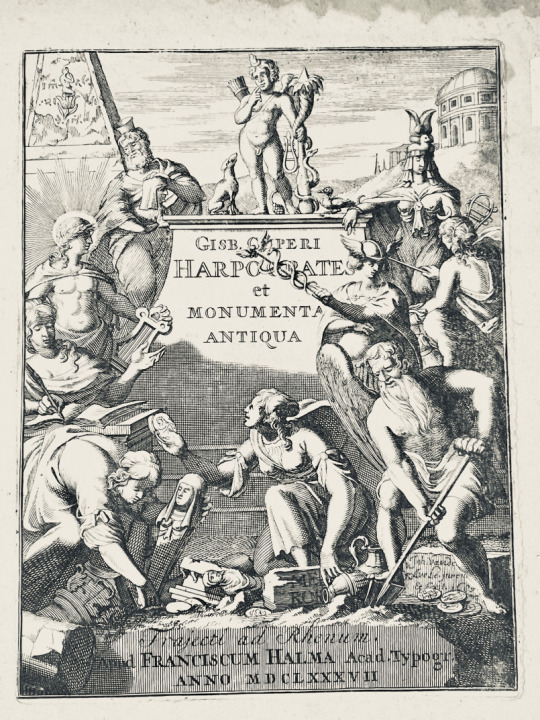
¶Harpocrates was adapted by the Greeks from the Egyptian child God Horus, who represented the newborn sun, rising each day at dawn. Harpocrates’s name was a Hellenization of the Egyptian Har-pa-khered or Heru-pa-khered, meaning “Horus the Child”. In the second century B.C., Egyptians connected Harpocrates with the mystic cult of the Egyptian goddess Isis. Harpocrates holds a finger to its lip for the Egyptians a symbolic gesture representing childhood.

¶Yet the Greeks mistook for a hush for silence., misinterpreting Harpocrates as the personification of silence, and this particular work is a study of statues and other art from classical antiquity that depict these later figures of silence. And again, the Roman interpretation added strength to the Mystery of silence.
The frontispiece signed and dated in the plate: Joh. van der Avele invention and fecit. Title page in red and black. This edition is enhanced with a letter of Etienne Le Moyne; this text has a half-title and the second text: Monumenta Antiqua. Cuper’s research is a precursor to art history and Winckelmann.
Brunet 6, no. 22603; Cicognara 3212; Ebert 5512; Graesse 2,308 , Item #388J
Price: $1,800.00
2). David, Jan David. 1545?-1613
Veridicus christianus: auctore P. Joanne David … Editio altera, auctior.
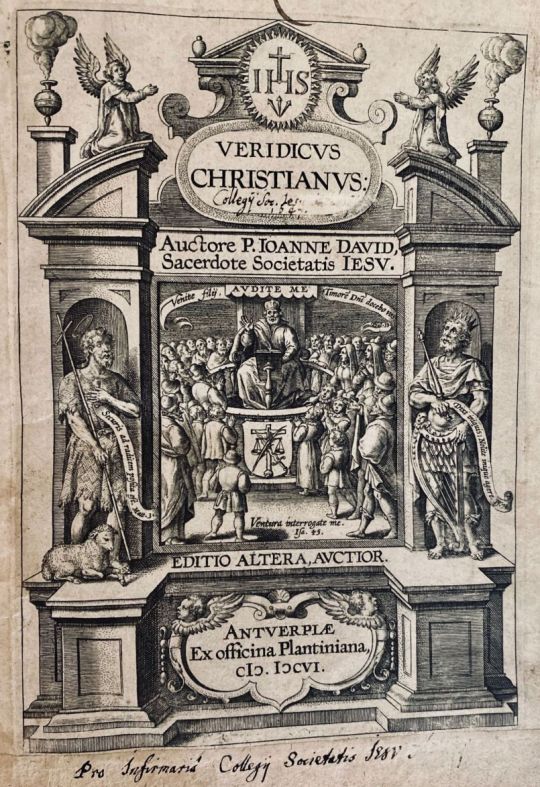
Antverpiæ ex officina Plantiniana, M. DCVI. Second edition. This copy is bound in full contemporary blind stamped calf over wooden boards with two working clasps. Quarto ‡4, ‡‡4, A-Z4, a-z4, Aa-Ee4.+ 100 Numbered Plates. With a special engraved t.p. with allegorical depiction of Christ carrying the cross, surrounded by ten artists at easels painting scenes from his life (as well as a few questionable profane subjects). The vovelle : The centers of the engraving and the volvelle (through which a string passes) are reinforced with small paper roundels printed with the monograms of Christ. The numbers are keyed to an “Indiculus orbitae” that follows (Bb1r-Bb2r). There a number, having been selected, is provided with a phrase from various Latin authors (listed on Bb2v), and a reference to one of the hundred sections that comprise the main text. It is suggested in Bibliotheca Belgica that this game may have been intended as a pious alternative to such superstitious books as Thuys der fortvnen.
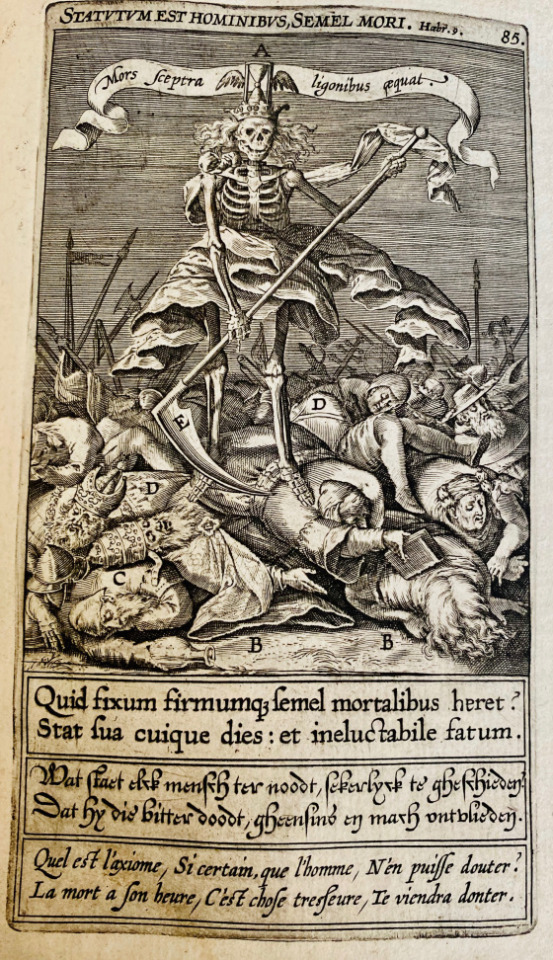
Veridicus Christianus emphasizes the Society of Jesus’ investment in thinking in, though, and about visual images that exemplify the supreme mystery of God. Published as a tool of devotion and meditations, it features one hundred chapters that encompass a wide
range of topics for reflection. Each chapter incorporates an extensive commentary that interprets the emblematic image David too follows the order in which we apprehend things with our senses, beginning with a visual representation at the head of each chapter. Then comes the explication. The symboli explicatio was considered necessary because cultivated readers would be more susceptible to a reasoned argument than a

picture. The text is divided into 100 chapters, each with an allegorical engraving incorporating letters keyed to the explanatory text and with marginal references. Each of the 100 numbered plates has a single line of Latin at the head giving the subject, with two-line explanatory verses below the allegorical engraving in Latin (roman letter), Dutch (civilité) and French (italic) First plate (following [2 daggers]4) is added title leaf for the ill., which were also published separately; see Bibliotheca Belgica. The added title reads: Icones ad Veridicvm Christianvm P. Ioannis David e Societate Iesv At the end is Device with compasses and the motto “constantia et labore” on Ee4r . This book is notoriously found defective in one way or another, this copy is perfect and complete. . Item #382J
De Backer-Sommervogel Vol.II col 1845 N. 5; Funck 302; Praz 313: EBIU D 17; Landwehr EFBLC 138; Landwehr FISP 253. Daly & Dimler CLE Jesuit Series Part one p160 #J.153.
Price: $5,500.00
3) David, Joannes David 1546-1613.
Duodecim specula deum aliquando videre desideranti concinnata.
Antwerp: Antverpiae: Ex officina Plantiniana, apud Ioannem Moretum, 1610, 1610. Theodor. Galle fecit. First Edition? This copy is bound in a contemporary soft vellum, (recovery vellum with writing. Faded and on the the inside. ) Ex libris ms.
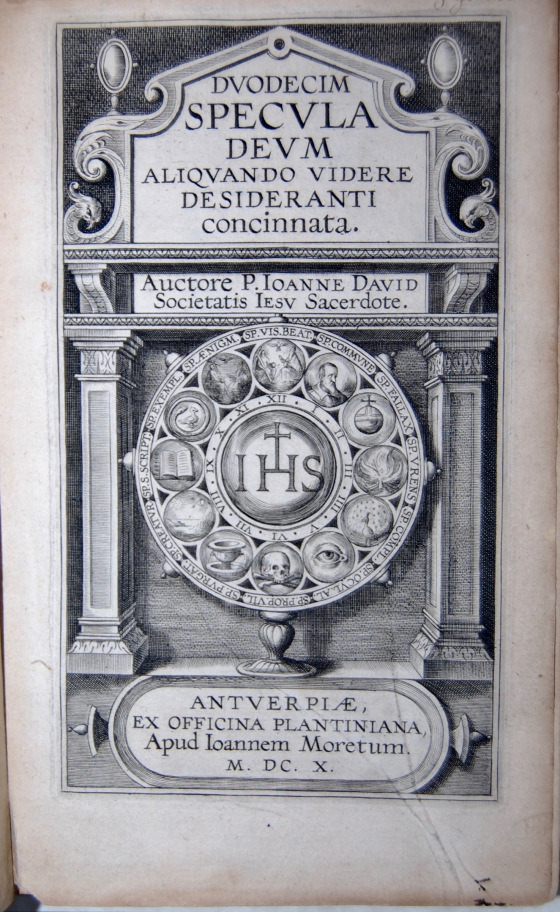
First edition of this wonderfully illustrated work about 12 mirrors mankind uses to try and see God. David was born at Courtrai and entered the society of Jesuits in 1581. He was distinguished for his zealous fight against heresy. “Emblem number with caption,pictura with motifs flagged, then subscriptio,prose identification flagged motifs,facing page with number followed by a prose conversation between Anima and Desiderus.
Youth edition with engravings only, without text. Each plate bears, at the top, a serial number and an inscription indicating the subject represented in the bottom part a Latin couplet with a summary explanation. RRef. Landwehr 188, Funck p. 303, BCNI 5556, Bibl. Belg. D 157, Praz p. 313 “scarce”
DeBacker-Sommervogel vol. II col.1851 no.20 ; McGeary & Nash. Emblem books at the Unviersity of Illinois,; G2; Daly & Dimler corpus Librorun eblematun(CLE) J141; Praz, M. Studies in 17th century imagery,; vol. I p.192 vol.. II, p. 46; Landwehr, J. Dutch emblem books,; Funck p. 303, BCNI 5556, Bibl. Belg. D 157; see also The Jesuits and the Emblem Tradition: Selected Papers of the Leuven International Emblem Conference, 18-23 August, 1996.
. Item #409J
Price: $1,900.00
4) Izquierdo, Sebastian Izquierdo, Saint Ignatius of Loyola
Praxis exercitiorum spiritualium P.N.S. Ignatti. Auctore P. Sebastiano Izquierdo Alcarazense Societatis Jesu.
Rome: Romae : Typis Joannis Francisci Buagni, 1695, 1695. Octavo 7 X 4.75 inches A-G8,H4 This copy is very clean and bound in full contemporary vellum. Landwehr, Romanic, 412.Sommervogel, IV, 70 1#4 ; Palau 291230; Landwehr:Romantic 412.; Praz,p.382. Item #716

The Jesuit Sebastián Izquierdo in his Práctica de los ejercicios espirituales, written in (Spanish in )1665 translated in to Italian the same year then in 1678 translated as here into Latin and later published in several translations and versions offers an illustrated guide to the Ignatian spiritual exercises. The illustrations, 12 of them, are the subject of image meditation which was a favorite method of the Jesuits who, beginning with the monumental Evangelicae Historiae Imagines (1593) of Jerónimo Nadal, actively took hold of religious iconography and adjusted and concentrated it for the teaching of the Societies ( and Ignatius’ ) vision. The images are not just simple depiction’s instead they are mnemonic devices. These images are points of departures and give the current 21st century reader a precious examples of images that inspire meditation, direct the reception of the teachings and anchor them in the memory. Particularly memorable is the Image of Hell on page 72, The lay-out shows the pedagogical intentions and possibilities of this little book: there are 12 parts consisting of 12 separate quires, numbered from ‘A’ to ‘M’ and paginated each from 1-12, each with its own full-page illustration , these could have been meant to be distributed separately – according to match the educational needs or level of the students. The Images are in high contrast, with plenty of Bloody and memorable images. The Puteus Abyssi depicts a poor man who is naked and sitting in a chair in some sort of oubliette. He has sevenswords, each with animal head handles, in him and each is strategically stuck in various parts of the body. The swords are labeled for the passions. Most interesting of these might be the sword marked ‘Vengeance’ it is hanging offer the mans head, the Idleness sword is stuck between his legs, Gluttony in his stomach, Lust … Envy in his back, Avarice between his Shoulders and Pride in his heart.Izquierdo was also the author of Pharus scientiarum, a treatise on a methodology to access knowledge,

conceived as a single science. In this work, he assimilated Aristotelian and Baconian logic, and he expressed some original ideas on mathematics and logic that have earned their author a reputation as an outstanding mathematician. Not just like his Spanish contemporaries John Caramuel or Tomás Vicente Tosca , but also significant foreign mathematicians as Athanasius Kircher , Gaspar Knittel or Gottfried Wilhelm Leibniz , the latter, in particular, cited with, his Disputatio of Combinatione, in Combinatorial Art (1666).
Price: $1,800.00
5) SCARLATINI, Ottavio Scarlatini
Homo et eius partes figuratus & symbolicus, anatomicus, rationalis, moralis, mysticus, politicus, & legalis, collectus et explicatus cum figuris
Augsburg & Dillingen, Johann Caspar Bencard, 1695. First and only Latin edition. Bound in a beautiful contemporary pig skin over wooden boards. Caillet 9948 (“unique in its genre”); Landwehr, German emblem books 530; Praz 490 note; R. Raybould, Emblemata 29. Item #734

With 42 engraved emblems revolving around the human body and body parts. It describes and depicts the human body in its details and in its entirety in every aspect conceivable. The book also discusses magic, in the strict sense of the word, revealing many marvellous secrets, such as the occult properties of saliva, urine, sperm, etc.”The erudition demonstrated by the author is really quite extraordinary” (Raybould) including metoposcopy (the interpretation of facial wrinkles for divination!). . Book One studies individual organs: heart, etc. And Book Two the overall dignity of the whole and aspects of human life.An appendix adds short accounts of several subjects, including “hieroglyphia” and “androgyni”, along with short works by other authors: Lactantius Firmianus’s “De opificio Dei”, Coelius Rhodiginus on humanity, and a long “Ode” to humanity: “Considerationes patheticae de creatione, & dignitate hominis” based on Trismegistus, Plato, Coelius and other ancient sources.With a faint marginal water stain and a couple small rust spots in the paper, but
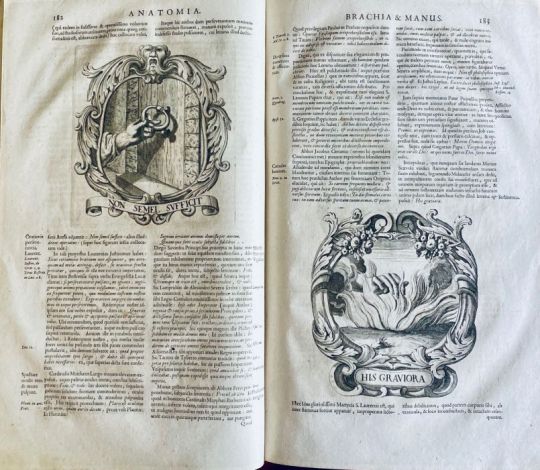
otherwise in fine condition. The binding shows a few scratches, cuts and stains, small cracks at the head and foot of the hinges and 1 sewing support broken at the hinge, but is still in good condition. A fascinating emblem book for both text and imagery (some of it now also humorous), and an impressive piece of book production.
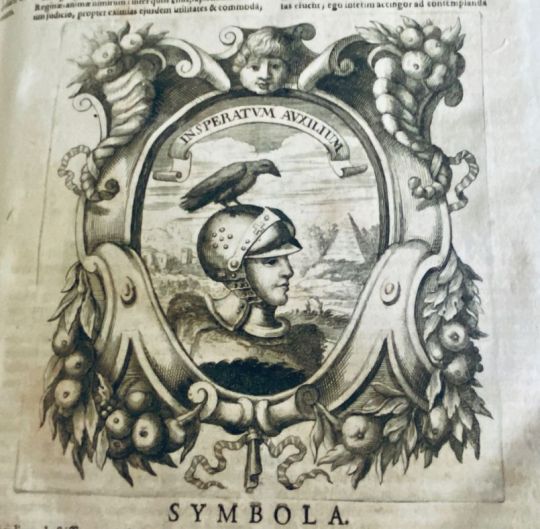
Price: $5,500.00
6). Sucquet, Anton Sucquet
Piæ considerationes ad declinandum à malo et faciendum bonum : cum iconibus Viae vitae aeternae R.P. Antonij Sucquet è Societate Iesu.
Viennæ Austriæ : Wien : [s.n.], 1672, 1672. Boetius a Bolswert and title by “I.M. Lerch sc. Viennae. Quarto,4 ¾ X 7 inches . ( no printed signatures) π 4 A-T4 V2. This copy is bound in original vellum. There is a really interesting modern bookplate on the pastedown. ¶ Praz, M. Studies in 17th cent. imagery (2nd ed.),; p. 506; Corpus librorum emblematum. Jesuit series,; J.1414; Landwehr, J. German emblem books,; 564; De Backer-Sommervogel,; VI, column 892, no. 2. Item #715
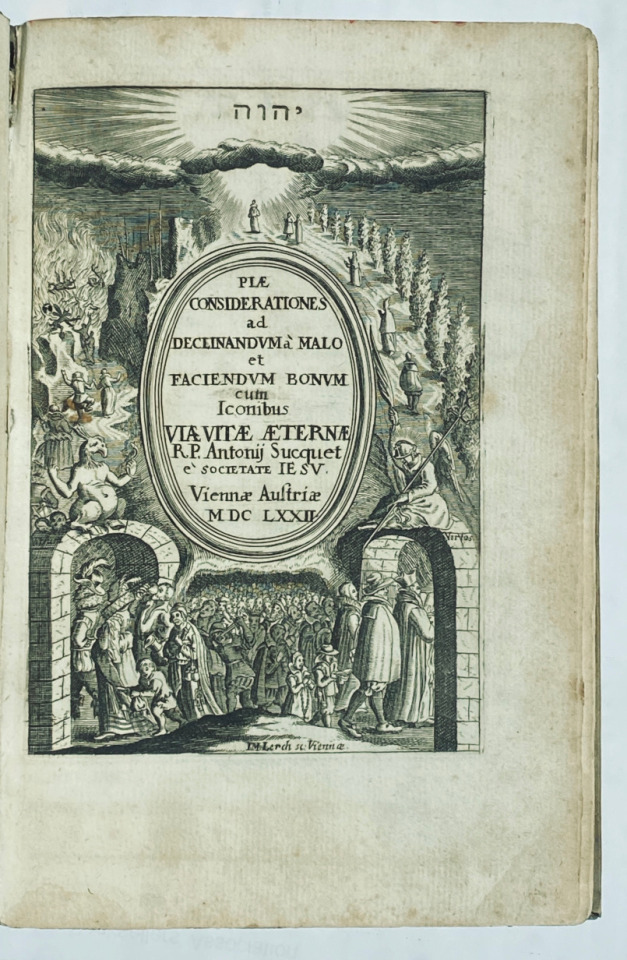
There is an engraved emblematic title page signed “I.M. Lerch sc. Viennae;” The other 32 illustrations (numbered 1-32) are full-page emblems engraved by Boetius a Bolswert–See Landwehr. ¶The Illustrations are printed on the verso of leaf, recto is blank; accompanied by explanatory text on facing leaf. The text and illustrations are printed within ruled border. This popular emblematical work is arranged as a series of meditations, by the Jesuit Antoine Sucquet. Many religious emblem books were published during the 17th and 18th centuries, and of these, Sucquet’s work was one of the most popular. Because of its engravings by Boëtius a Bolswert , it was especially important for the development of the 17th-century Christian iconography. The counter-reformation produced a great number of emblematic meditation-books where text and illustrations are interwoven. Emblem books were therefore much favoured by the Jesuits for the purposes of teaching, as religious propaganda, and to provide subjects for meditation. The 17th-century Jesuit curriculum prescribed that emblems were composed in the schools. Members of the highest classes in the Flemish Jesuit colleges each composed an emblem, and the production of the entire class was collected in commemorative albums painted by professional artists and calligraphers. The meditation on the soul’s relation to Christ was precisely guided by provision of references in the engravings. The first religious catholic emblem book was published in 1571 and composed by Arias Montanus. In 1601 Jan David composed the first Jesuit emblem book, the “Veridicus Christianus”. Sucquet’s work is composed around the widely spread concept of the “homo viator in bivio”, the creature who during his life again and again arrives at the cross and has to make the good choice for the narrow and difficult path to his eternal destination. Sucquet made clear that vision is the most important sense of a human being. It had foundational importance for the Christian iconography of the seventeenth century. According to Brunet the work was very much searched after by the pious for its texts, by the curious minds for the 32 engravings by Boetius a Bolswert
Price: $1,900.00
7) Venius, Otto van Veen
Theater moral de la vida humana, en cien emblemas; con el Enchiridion de Epicteto, y La tabla de Cebes, philosofo platonico.
Antwerp: Amberes,{Antwerp} Por Enrico y Cornelio Verdussen 1701, 1701. The Rubens master. third Edition.This large folio is bound in full contemporary vellum with gilt tooling. Snags repaired in the blank of the title page and on the folding Engraving , without damaging the text. Scattered freckles. Good copy. Landwehr, Dutch 240; Landwehr, Low Countries 678. (cfr. PRAZ, Studies in seventeenth-century imagery I pp.523-524 & Peeters Fontainas Bibliographie des impr. espagn. des Pays-Bas mérid. 1275;. Folio. 14 x 9 inches * 6, ** 4, *** 2, A-Z4, 2A-2C4 / a4, a-f4, g2. Item #97
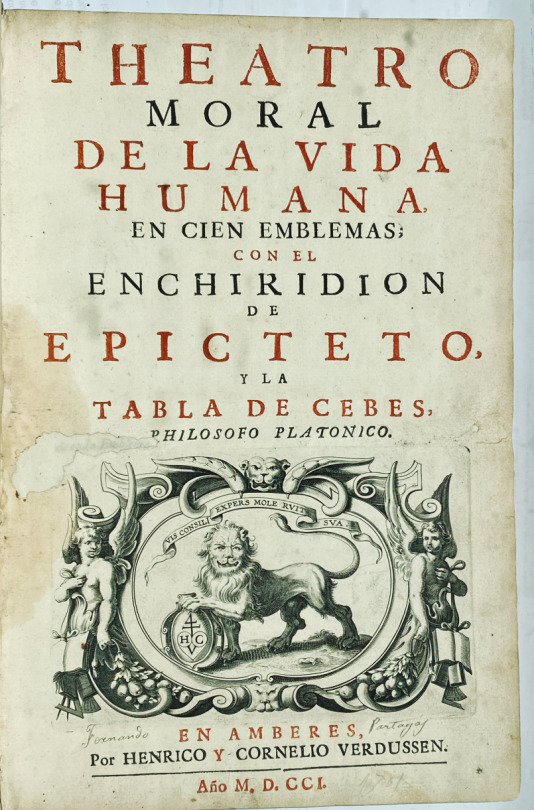
This Emblem book is made up of three Stoic works, beginning with Text from Horace in latin with 103 copper plates of engravings, That is a full page engraving of Vaenius by his daughter Gertrude van Veen engraved by Pontius.
These emblems also appeared in “Emblems from Horace, but not directly, these engravings represent both allegoric and general passages from Horace, these are in Spanish. The Horace is followed by
The Table of Cebes which has a large folding plate (16 x 13 inches) Cebes’ Tablet is an Ekphrastic work interpreting a probably mythical Tablet which symbolically represents “the whole Truth of Human life” Cebes is one of the characters in The Phædo of Plato. Xenophon tells us that Cebe was in the inner circle of Socrates’ friends. This is followed by The ENCHRIDION of Epictetus, in spanish. This manual is a ‘hands-on’philosophical collection of epigrams which promises to free the mind from Fear and enslavement to false Ideas.

Price: $3,500.00


Seven Emblem Books and Two others To see the web page which goes with this choose the link below. Seven Emblem books and two others!
4 notes
·
View notes
Text
Metamorphoses: III, 379–470
Plötzlich sagte, getrennt vom treuen Zug der Gefährten, Narziss: »Ist einer da?« und »Da.« antwortete Echo. Jener macht halt und schickt in jede Richtung die Blicke, Ruft laut: »Komm!«, doch gerufen ruft sie dasselbe dem Rufer. Jener blickt zurück und sagte, als niemand hervorkam: »Wieso fliehest du mich?«, und als Antwort hört' er dasselbe. Fährt vom Schein der Antwort getäuschet fort und er sagt nun: »Lass uns treffen!« Und Echo, die keinem anderen Rufe Lieber Antwort gäbe, gibt »Treffen!« als Antwort zurück ihm, Selbst vertraut sie den Worten und tritt hinaus aus dem Walde, Um den ersehnten Hals mit eigenem Arm zu umschlingen. Narziss fliehet und sagt im Fliehen: »Hör auf zu umarmen! Eher sterb' ich dahin, bevor wir in Lieb' uns vereinen!« Echo antwortet' nichts, nur dies: »In Lieb' uns vereinen!« Sie, verschmähet, versteckt sich im Wald und decket mit Laube Sich das errötete Antlitz und zieht in einsame Höhlen. Doch die Liebe besteht und wächst vom Schmerz der Verschmähten, Dauernde Sorgen schwächen der Nymphe den elenden Körper, Abmagerung zieht die Haut zusammen, die Kräfte des Köpers Lösen sich ganz in der Luft. Es bleiben nur Stimme und Knochen; Unverändert die Stimme, die Knochen – so sagt man – wie Steine. Daher verbirgt sie im Wald sich, wird nicht auf Bergen gesehen, Doch von allen gehört; so lebt sie als Schall, der bewohnt sie. So verhöhnte sie er und verhöhnten die Nymphen der Wellen Und der Berge sie, wie früher die männlichen Scharen. Schließlich sagte verschmäht eine, hob zum Himmel die Hände: »So mag lieben er selbst, doch nie, was er liebet, erreichen!« Diesen berechtigten Wunsch gewährt' die rhamnusische Göttin. Frei war der Quell von Schlamm und silbern von schimmernden Wellen, Da sie weder von Hirten und noch von grasenden Ziegen Oder von anderem Vieh gerührt, von keinem der Vögel Noch von Wild gestört und noch von fallenden Zweigen. Rasen befand sich umher, den nahes Gewässer ernährte, Und ein Wäldchen, das ließ unerwärmt den Ort von der Sonne. Hier, vom Eifer der Jagd und vom Durst ermüdet, ließ Narziss, Und vom Anblick des Ortes gelockt und dem Quelle, sich nieder. Während den Durst er zu löschen verlangt, wuchs anderer Durst ihm, Während er trinkt, ergriffen vom Schein des gesehenen Abbilds, Liebt er körperlos' Hoffnung, er hält für Körper das Wasser. Staunt sich an und beharrt unbewegt an derselbigen Miene, Die wie aus parischem Marmor geformt, ein Götterbild, hochblickt. Liegend am Boden betrachtet das Doppelgestirn seiner Augen Er und die Locken, die gleich dem Bacchus und gleich dem Apoll sind Auch die bartlosen Wangen, den elfenbeinernen Halse, Und den Reiz des Mundes, die weißumringete Röte, Alles bewundert er, was ihm selbst Bewunderung einbracht'. Töricht verlangt er sich selbst, der sich mustert, wird selber gemustert, gleichsam begehrt er, begehrt, entflammt und brennet in Liebe. Wie oft gab er dem täuschenden Quell vergebliche Küsse! Wie oft taucht er direkt ins Wasser die Glieder, zu greifen, Den er gesehen, den Hals, bekommt ihn dort nicht zu fassen. Ratlos, was er sieht, doch in Liebe entbrannt dem Gesehnen, Und derselbe ihn täuschende Wahn erregt ihm die Augen. »Tor, wieso greifst du vergeblich nach fliehenden Schatten? Nirgendwo ist, was du suchst! Was du liebst – verbann es! – verdirbst du. Was du erblickst, der Schatten, ist nichts als gespiegeltes Trugbild. Dieser ist eigen dir nicht, mit dir soll er kommen und bleiben, Und fortschreiten mit dir, bist du zum Fortschreiten du fähig!« Weder die Sorge der Ceres und noch die Sorge des Schlafes Kann ihn ziehen von dort, doch ausgestrecket im schatt'gen Grase schaut er im maßlosen Licht die täuschende Spieglung, Und durch die eigenen Augen vergeht er, ein bisschen erhoben, Streckt er seine Glieder zu ihn umgebenden Sträuchern »Hat, o Sträucher, jemals einer«, sagt er »schlimmer geliebet? Denn ihr wisset und wart schon vielen die rettende Zuflucht. Wessen, da ihr so viele Jahrhunderte lebend verbrachtet, Der so verging, erinnert ihr euch im dauernden Zeitraum? Mir gefällt, was ich sehe, doch was mir gefällt und ich sehe Finde ich dennoch nicht; – So hält der Wahn den Verliebten! Und ich leide noch mehr, es trennt ja weder die See uns, Noch eine Straße, noch Berge, noch zugeschlossenes Stadttor. Sind von kleinem Wasser getrennt! Selbst will er umarmt sein: Denn soviel wir dem flüssigen Wasser hinstrecken die Küsse, Sooft streckt er entgegen sein stolzes, holdes Gesicht mir. Hältst du Berührung für möglich; – so klein, was die Liebenden hindert! Wer du bist, komm heraus! Was täuschst du, mein einziger Knabe, Oder wohin gehst du fort? Denn sicher ist's Form nicht und Alter, Drum du mich fliehst, denn mich auch liebten sehnlich die Nymphen! Hoffnung hab' ich, doch welche verspricht dein freundlich' Gesicht mir, Und wenn ich streckte die Arme zu dir, streckst du auch von selbst sie, Wenn ich lächelte, lachst du mich an; schon oft sah ich Tränen Als ich weinte mit dir und dem Nicken nickst du zurück mir Und, soviel ich vermute aus Zucken verlockenden Mundes, Sagst du Worte, die nicht die unseren Ohren erreichen! Dieser bin ich! Ich fühlt's und täuscht mich nicht länger die Spieglung. Brenne in Liebe zu mir, ich zeug' und ertrage die Flammen. Was soll ich tun? Frag ich oder er? Was werd' ich dann fragen? Was ich verlange ist mein; ohnmächtig macht mich der Reichtum. O könnt' nur ich mich trennen von unserem eigenen Körper! Was ein Verliebter noch wünscht: Ich wollt, was wir lieben, sei ferne! Schon raubt Schmerz mir die Kräfte und nicht die dauernden Zeiten Meines Lebens verbleiben, ich geh in der Jugend zugrunde.«
forte puer comitum seductus ab agmine fido dixerat: 'ecquis adest?' et 'adest' responderat Echo. hic stupet, utque aciem partes dimittit in omnis, voce 'veni!' magna clamat: vocat illa vocantem. respicit et rursus nullo veniente 'quid' inquit 'me fugis?' et totidem, quot dixit, verba recepit. perstat et alternae deceptus imagine vocis 'huc coeamus' ait, nullique libentius umquam responsura sono 'coeamus' rettulit Echo et verbis favet ipsa suis egressaque silva ibat, ut iniceret sperato bracchia collo; ille fugit fugiensque 'manus conplexibus aufer! ante' ait 'emoriar, quam sit tibi copia nostri'; rettulit illa nihil nisi 'sit tibi copia nostri!' spreta latet silvis pudibundaque frondibus ora protegit et solis ex illo vivit in antris; sed tamen haeret amor crescitque dolore repulsae; extenuant vigiles corpus miserabile curae adducitque cutem macies et in aera sucus corporis omnis abit; vox tantum atque ossa supersunt: vox manet, ossa ferunt lapidis traxisse figuram. inde latet silvis nulloque in monte videtur, omnibus auditur: sonus est, qui vivit in illa. Sic hanc, sic alias undis aut montibus ortas luserat hic nymphas, sic coetus ante viriles; inde manus aliquis despectus ad aethera tollens 'sic amet ipse licet, sic non potiatur amato!' dixerat: adsensit precibus Rhamnusia iustis. fons erat inlimis, nitidis argenteus undis, quem neque pastores neque pastae monte capellae contigerant aliudve pecus, quem nulla volucris nec fera turbarat nec lapsus ab arbore ramus; gramen erat circa, quod proximus umor alebat, silvaque sole locum passura tepescere nullo. hic puer et studio venandi lassus et aestu procubuit faciemque loci fontemque secutus, dumque sitim sedare cupit, sitis altera crevit, dumque bibit, visae correptus imagine formae spem sine corpore amat, corpus putat esse, quod umbra est. adstupet ipse sibi vultuque inmotus eodem haeret, ut e Pario formatum marmore signum; spectat humi positus geminum, sua lumina, sidus et dignos Baccho, dignos et Apolline crines inpubesque genas et eburnea colla decusque oris et in niveo mixtum candore ruborem, cunctaque miratur, quibus est mirabilis ipse: se cupit inprudens et, qui probat, ipse probatur, dumque petit, petitur, pariterque accendit et ardet. inrita fallaci quotiens dedit oscula fonti, in mediis quotiens visum captantia collum bracchia mersit aquis nec se deprendit in illis! quid videat, nescit; sed quod videt, uritur illo, atque oculos idem, qui decipit, incitat error. credule, quid frustra simulacra fugacia captas? quod petis, est nusquam; quod amas, avertere, perdes! ista repercussae, quam cernis, imaginis umbra est: nil habet ista sui; tecum venitque manetque; tecum discedet, si tu discedere possis! Non illum Cereris, non illum cura quietis abstrahere inde potest, sed opaca fusus in herba spectat inexpleto mendacem lumine formam perque oculos perit ipse suos; paulumque levatus ad circumstantes tendens sua bracchia silvas 'ecquis, io silvae, crudelius' inquit 'amavit? scitis enim et multis latebra opportuna fuistis. ecquem, cum vestrae tot agantur saecula vitae, qui sic tabuerit, longo meministis in aevo? et placet et video; sed quod videoque placetque, non tamen invenio'++tantus tenet error amantem++ 'quoque magis doleam, nec nos mare separat ingens nec via nec montes nec clausis moenia portis; exigua prohibemur aqua! cupit ipse teneri: nam quotiens liquidis porreximus oscula lymphis, hic totiens ad me resupino nititur ore. posse putes tangi: minimum est, quod amantibus obstat. quisquis es, huc exi! quid me, puer unice, fallis quove petitus abis? certe nec forma nec aetas est mea, quam fugias, et amarunt me quoque nymphae! spem mihi nescio quam vultu promittis amico, cumque ego porrexi tibi bracchia, porrigis ultro, cum risi, adrides; lacrimas quoque saepe notavi me lacrimante tuas; nutu quoque signa remittis et, quantum motu formosi suspicor oris, verba refers aures non pervenientia nostras! iste ego sum: sensi, nec me mea fallit imago; uror amore mei: flammas moveoque feroque. quid faciam? roger anne rogem? quid deinde rogabo? quod cupio mecum est: inopem me copia fecit. o utinam a nostro secedere corpore possem! votum in amante novum, vellem, quod amamus, abesset. iamque dolor vires adimit, nec tempora vitae longa meae superant, primoque exstinguor in aevo.
1 note
·
View note
Photo
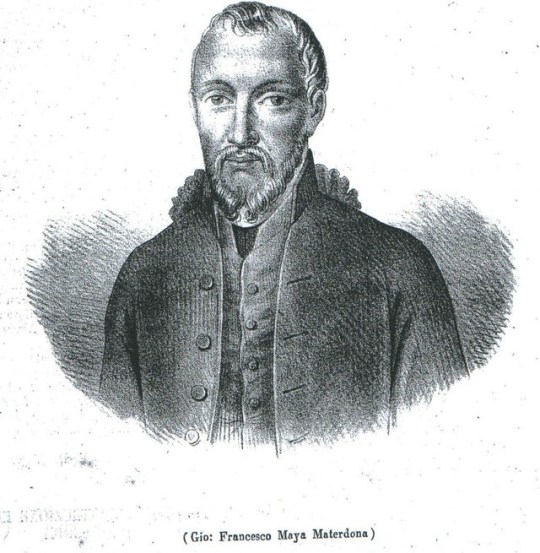
Nuovo post su http://www.fondazioneterradotranto.it/2018/02/19/mattarella-la-cagnetta-mesagne-larcivescovo-brindisi/
Mattarella, la cagnetta di Mesagne, e l'arcivescovo di Brindisi
di Armando Polito
Può sembrare stravagante o poco serio dedicare un post ad un animale associato ad un alto prelato e qualcuno arriverà perfino a pensare ad una qualche velata allusione alla più alta carica dello Stato, ingannato da una superficiale considerazione della punteggiatura del titolo, in cui le due virgole che racchiudono la locuzione cagnetta di Mesagne attribuiscono alla stessa, in base alle regole grammaticali ancora, nonostante la Buona sacuola …, in vigore, una valenza inequivocabilmente appositiva. Va da sé che l’assenza di virgola dopo Mesagne avrebbe, al contrario, convalidato un’allusione che in altri tempi mi avrebbe forse procurato l’accusa di vilipendio … La genesi di quanto sto per dire è assolutamente casuale, vale a dire legata occasionalmente ad uno studio, che sarà oggetto di un prossimo post, su Gianfrancesco Maia Materdona, un poeta mesagnese del XVII secolo.
L’unica sua biografia è quella lasciataci da Ortensio De Leo (1712-1791), datata 1770, custodita nella Biblioteca pubblica arcivescovile “Annibale De Leo” a Brindisi (ms. D/14).
Rimase inedita fino al 1974, quando venne pubblicata da Wanda De Nunzio-Schilardi in Annali della facoltà di Magistero dekk’Università di Bari, v. XIII. Qui riproduco, trascrivo e commento direttamente dal manoscritto originale la parte che ci interessa,
da carta 10r
Si recò finalmente in Mesagne, e quivi nell’anno 1633 provò il dispiacere di essergli morta la sua Cagnolina Bolognese, tutta biancha,
carta 10v
biancha, e a lui molto cara, che fe sepelire entro il pariete di un suo giardino di delizie fuori le Mura, al presente detto dell’Impalata posseduto da quel Marchese con i seguenti versi fatti incidere in una bianca lapide, ma per la maggior parte corrosi dal tempo: CANA CANIS CANO. TEGOR HOC SUB MARMORE NOMEN/MATTARELLA MIHI. FELSINA ME GENUIT./LUSTRUM, ET DIMIDIUM VIXI FIDISSIMA CUSTOS./OBLONGO, ET CRISPO VELLERE DIVES ERAM./PARVULA BLANDA FUI. ITALIAM TRANSVECTA PER ORBEM./ET NUMQUA1 DOMINO DISSOCIATA MEO./HIC TUMULUM LACRIMIS DICAT. QUO, DEPRECOR, IBIS/FAC TANTI MEMORES, HOSPES, AMORIS OPUS./FRANCISCUS MAIA MATERDONA HERUS/POSUIT IDIB(US) IULII/MDCXXXIII
Interrompo la trascrizione qui per tradurre l’epigrafe che è in distici elegiaci: Parlo (io) bianca cagnolina. Sono sepolta sotto questo marmo. mi chiamo Mattarella. Sono nata a Bologna. Ho vissuto fedelissima custode per cinque anni e mezzo. Ero dotata di un pelo lungo e riccio. Sono stata piccolina e affettuosa. Portata per l’Italia e per il mondo, mai mi sono separata dal mio padrone. Egli tra le lacrime mi dedica la tomba. Viandante, ti prego, Dovunque andrai, ti prego, fà che tu ricordi questa testimonianza di tanto amore. Il padrone Francesco Maia Materdona pose il 15 luglio 1633. Faccio notare, perché, cone vedremo fra pochissimo, costituisce la pietra dello scandalo, il gioco di parole, espediente privilegiato della letteratura barocca, CANA (aggettivo femminile singolare=bianca), CANO (prima persona singolare dell’indicativo presente di canere= io canto) e CANIS (sostantivo maschile o femminile, qui femminile=cagnetta).
Riprendo la trascrizione.
Ciò che poi circa la fine del medesimo secolo diede motivo di giusto sdegno allo zelantissimo Arcivescovo di Brindisi Francesco Ramirez Domenicano, il quale essendosi abbattuto nella suddetta iscrizione, ed avendone letto il primo verso domandò que’ suoi Diocesani, qual significato avesse; ed essendo stato informato, che era il sepolcro di un cane, esclamò in sua lingua spagnola: Cuerno, Cuerno, Cuerno, insultando con allusiva derisione il Cana canis cano. Ma simili trasporti di passione debbono esser condonati alla fantasia di un Poeta, giacché si legge, che il gran Petrarca ebbe ancora una gran
da carta 11r
gran passione verso di un suo Gatto, che indi morto fù fatto inbalzamare, e così tuttora esiste in una stanza in Arquà villa del Padovano, ove sono le memorie dell’istesso Poeta con i seguenti versi: Etruscus gemino vates exarsit amore./Maximus ignis ego, Laura secundus erat./Quid rides? Divinae illi si gratia formae,/me dignum eximio fecit amore fides./Si numeros, geniumque sacris dedit illa libellis,/causa ego ne saevis muribus esca forent.
______________________________________________________________________________________________________________________________________________
Arcebam sacro vivens a limine mures,/ne Domini exitio scripta deserta darent./Incutio trepidis eadem defuncta pavorem/et viget exanimi in corpore prisca fides. L’epigrafe per il gatto del Petrarca fu composta in distici elegiaci dal canonico Antonio Quarenghi (1547-1633) ma il testo trascritto nel manoscritto contiene alcuni errori, come mostra quello che ho trascritto dal monumento in basso riprodotto.
Etruscus gemino vates exarsit amore./Maximus ignis ego; Laura secundus erat./Quid rides? Divinae illam si gratia formae/me dignam eximio fecit amante fides./Si numeros geniumque sacris dedit illa libellis,/causa ego ne sævis muribus esca forent.
Arcebam sacro vivens à limine mures,/ne domini exitio scripta diserta forent./Incutio trepidis eadem defuncta pavorem/et viget exanimi in corpore prisca fides.
(Il poeta toscano arse di un duplice amore. Il fuoco più grande ero io, Laura il secondo. Che ridi? Se la grazia di una divina bellezza rese lei degna di un esimio amante, me la fedeltà. Se lei ispirò agli scritti ritmi e inventiva io fui il motivo per cui non diventassero cibo per i crudeli topi.
Da viva tenevo lontani i topi dalla sacra soglia perché gli scritti del padrone non fossero abbandonati alla rovina. Io stessa da morta incuto paura a loro ansiosi e l’antica fedeltà è viva nel corpo esanime).
Oggi sono proprio soddisfatto, perché son riuscito a rievocare due poeti in modo non convenzionale, cioè mettendo in campo non le loro poetiche o avventati confronti o, peggio ancora, improbabili classifiche, ma il comune amore per gli animali, che, poi, è anche il mio. L’amore per la verità, però, e ancor più la voglia di compensare certe crudeli ingiustizie del destino mi obbligano ad informare il lettore che il tumulo della gatta di Arquà in realtà è una realizzazione dovuta agli inizi del XVII secolo a Girolamo Gabrielli, nuovo proprietario dell’immobile, quando questo era già diventato una specie di museo meta di visitatori. Il Petrarca non ci ha lasciato nessun pensiero riguardante i gatti, ma tutto probabilmente è nato da un affresco di autore anonimo del XIV secolo (dunque coevo al grande poeta) visibile nella Sala dei Giganti della Reggia Carrarese a Padova, ove l’animale acciambellato a destra è stato identificato come un gatto, anche se a me sembra, col muso così allungato, più un cane (dettaglio ingrandito).
E pure la poesia ebbe la sua parte di responsabilità nel consacrare quasi definitivamente quello che per me è un autentico equivoco ispirato da intenti, quelli del Gabrielli, che con locuzione moderna non avrei difficoltà a definire pubblicità ingannevole. La sua parte di responsabilità, poi, ha Alessandro Tassoni ne La Secchia rapita (prima pubblicazione a Parigi nel 1622), VIII, 33, vv. 5-8: Dove giace colui, nelle cui carte/l’alma fronda del Sol lieta verdeggia;/e dove la sua Gatta in secca spoglia/guarda dai topi ancor la dotta soglia. Va detto, però che proprio un comtemporaneo del Tassoni fa riferimento al tema non senza irriverente ironia: Francesco Driuzzo in una canzone inserita in La casa ed il sepolcro del Petrarca in Arquà, Gattei, Venezia, 1827, p. 67 così poetava: S’ei cantò di un’alma bella/le fattezze e i pregi rari,/perché mai nemica stella/sol vi fa di Laura avari/e mostrate contraffatta/questa secca e sozza gatta?/Colei che dal Troian fu in Ilio tratta,/cambiossi in una vil secchia di legno,/e qui per Laura traformossi in gatta./Perché alcun non pensi male/io vo’ dir che questa gatta/fu quel ciuccio d’animale,/che la parte aveva fatta/di cambiarsi in bella donna:/ma vestita poi di gonna,/visto un topo, l’addentò,/ed in gatta ritornò. E a distanza di più di un secolo Gaetano Rossi con un sonetto inserito in Lagrime in morte di un gatto, s. n., s. l., 1741, p. 92: Vago, e bello non men, che destro, e forte/gatto fra quanti mai formar Natura/seppe; già un tempo mio diletto, e cura,/or mio cordoglio, or vittima di morte./Poiché sì volle la mia cruda sorte,/gli occhi da quel pianeta, ov’hai sicura/sede, ov’hai premio de la tua bravura,/volgi al mio pianto, e a le ,ie guance smorte;/o a quella almeno di messer Petrarca/gatta, ch’ei pianse al Mondo unica e sola,/lieto t’accoppia, e manda in giù la razza./Morranno intanto in mezzo de la piazza/gli assassini appiccati per la gola,/e a te porrem grande Epitafio, ed Arca.
Il pericolo, però, che la favoletta della gatta di Petrarca continui a rinnovarsi è sempre in agguato, se si pensa che Detlef Bluhm autore tedesco nato nel 1954, per così dire, monotematico2, in Il gatto che arrestava i malviventi e altre storie, Corbaccio, Milano, 2015, si spinge ad inventare l’esistenza di una lettera scritta dal Petrarca al Boccaccio una settimana prima di morire, nella quale descrive con dovizia di particolari come la fantomatica gatta sia entrata nella sua vita e vi sia rimasta.
A questo punto il lettore si chiederà se a qualcuno non sarà venuto in mente di darle un nome. Eccolo servito. In Mario Scaffidi Abbate, La gatta. Anatomia di un amore, Meligrana, Tropea, 2014, si leggono a p. 9 questa battute: – E se la chiamassimo Sofonisba?-. -Sofonisba?!-. – Perché no? La gatta del Petrarca si chiamava così, l’abbiamo pure vista, non ti ricordi? -. – Sì, seicento anni fa! -. – Np, non più di dieci, o quindici, ad Arquà, nell’ultima casa del Poeta. Imbalsamata -.
Lucidamente ed amaramente, però, già nel 1846 Niccolò Tommaseo in Ricordi sui colli euganei, s. n. s. l., p. 15 scriveva: La tavola di Giotto che ornò la casa del Petrarca, è perita la signoria Carrarese: ma consoliamoci; la gatta del Petrarca non ha abbandonato il suo posto. E molti di coloro che visitano Arquà non per amore del dolce tuo canto, o Poeta, o dell’ameno soggiorno, ma lo visitano perch’altri l’ha visitato; guarderanno più attentamente alla gatta che ai colli, più alla gatta che ai due terzetti del- l’Alfieri, che sono de’ meglio temprati e più antichi versi ch’abbia la moderna poesia; più alla gatta che al nome di Giorgio Bjron, che senza titolo né altra parola sta confuso fra tanti, e dice più d’ogni lode.
Per fortuna, aggiungo io, restano, finché la Terra ruoterà e la nostra razza sopravviverà, pur nel rischio dell’oblio, le opere e, al di là delle invenzioni, le fonti. E nel chiudere, ripromettendomi a breve, come ho anticipato, di parlare della cospicua produzione del letterato mesagnese, mi piace, consapevole di autoincludermi in un certo senso nel novero dei superficiali stigmatizzati dal Tommaseo, ricordare che qualcosa resta della tomba di Mattarella in quella che fu contrada Impalata a Mesagne, oggi via Maia Materdona, cioè proprio l’epigrafe, murata dopo il civico 32 all’incrocio con Via Solferino.
Sarò grato a chiunque invierà un’immagine sostitutiva più leggibile. Nel frattempo, rubando alla stessa epigrafe immagine e parole finali, invito il viandante che si trovi a passare su quella via a captare con un po’ di fantasia il disappunto che ancora vi aleggia dell’arciprete Ramirez col suo Cuerno, cuerno, cuerno!, interiezione consona ad un prelato non per il significato letterale dello spagnolo cuerno, che corrisponde al nostro corno, quanto per quello traslato corrispondente al nostro diavolo. E per facilitargli il compito, dopo aver ricordato che Francesco Ramirez (1648-1715) da Toledo fu arcivescovo di Brindisi dal 1689 al 1697 e di Agrigento dal 1697 fino alla morte e che nella città siciliana fondò il Collegio dei SS. Agostino e Tommaso, riproduco di seguito i due monumenti che ivi gli furono dedicati, uno lapideo, posto nell’ingresso, nel 1722 e uno ligneo, nell’aula di sacra teologia, nel 1726, opera del maestro agrigentino Onofrio Vicari, recante in cima il suo ritratto ad olio.
D(EO)O(PTIMO) M(AXIMO)
iLLUSTR(ISSIM)US ET REVER(ENDISSIM)US D(OMI)NUS S(ACRAE) T(HEOLOGIAE) M(AGISTER) FRA D(OMINUS) FRANCISCUS RAMIREZ/EX ILLUS(TRISSI)MO PRAEDICATORUM ORDINE ARCHIEPISCOPUS BRUNDUSINUS/EPISCOPUS AGRIGENTINUS DOCTRINA ET ELOQUENTIA EXIMIUS INSIGNE HOC/COLLEGIUM SUB SS. AUGUSTINI ET THOMAE AUSPICIIS FUNDAVIT, EREXIT, DOTA/VIT IN EOQ(UE) PUBLICAS CATHEDRAS MATUTINAM SS. CANONUM ET VE/SPERTINAM THEOLOGIAE MORALIS INSTITUIT. ACERRIMUS IMMU/NITATIS ECCLESISTICAE PROPUGNATOR OBIIT ROMAE ANNO DOMINI/MDCCXV AETATIS SUAE 67. COLLEGIUM BENEFACTORI SUO/MONUMENTUM HOC POSUIT DEPUTATIS R(EGIIS) REVER(ENDISSIM)IS DD/ U(TRUSQUE) I(URIS) D(OCTORE) CAN(NONICO) D(OMINO) SALVATORE MARCHESE U(TRIUSQUE) I(URIS) D(OCTORE) ET S(ACRAE) T(HEOLOGIAE) P(ROFESSORE)/CAN(ONICO) D(OMINO) GASPARE SALERNO ET CAN(ONICO) D(OMINO) LAURENTIO/PITACCIOLO/ANNO D(OMI)NI 1722
(A Dio Ottimo Massimo. L’illustrissimo e reverendissimo signore maestro di sacra teologia Fra Don Franceso Ramirez dell’illustrissimo ordine dei predicatori, arcivescovo di Brindisi, vescovo di Agrigento, esimio per dottrina ed eloquenza, fondò eresse e dotò questo insigne collegio sotto gli auspici dei santi Agostino e Tommaso ed in esso istituì pubbliche cattedre, la mattutina dei sacri canoni, la serale di teologia morale. Acerrimo difensore dell’immunità ecclesiastica, morì a Roma nell’anno del Signore 1715 all’età di 67 anni. Il collegio al suo benefattore pose questo monumento essendo deputati regii i reverendissimi Signori canonico Don Salvatore Marchese dottore in entrambi i diritti, canonico Don Gaspare Salerno dottore di entrambi i diritti e professore di sacra teologia e canonico Don Lorenzo Pitacciolo nell’anno del Signore 1722).
____________
1 Errore per numquam.
2 Basta considerare gli altri titoli pubblicati in traduzione italiana sempre da Corbaccio: Impronte di gatto, Corbaccio (2004); La gatta che amava le acciughe, Corbaccio (2007); Tutto quello che vorreste sapere sui gatti (2014); Gatti di lungo corso (2017); I gatti e le loro donne (2017).
#Armando Polito#Franceso Ramirez#Gianfrancesco Maia Materdona#Mesagne#Ortensio De Leo#Paesi di Terra d’Otranto#Spigolature Salentine
0 notes